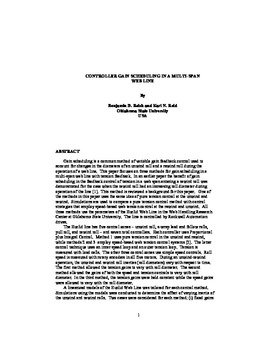| dc.contributor.author | Reish, Benjamin D. | |
| dc.contributor.author | Reid, Karl N. | |
| dc.contributor.other | International Conference on Web Handling (2019) | |
| dc.date.accessioned | 2019-06-10T15:04:58Z | |
| dc.date.available | 2019-06-10T15:04:58Z | |
| dc.date.issued | 2019-06 | |
| dc.identifier | oksd_icwh_2019_reid3 | |
| dc.identifier.citation | Reish, B. D., & Reid, K. N. (2019, June). Controller gain scheduling in a multi-span web line. Paper presented at the Fifteenth International Conference on Web Handling (IWEB), Stillwater, OK. | |
| dc.identifier.uri | https://hdl.handle.net/11244/320343 | |
| dc.description.abstract | Gain scheduling is a common method of variable gain feedback control used to account for changes in the diameters of an unwind roll and a rewind roll during the operation of a web line. This paper focuses on three methods for gain scheduling in a multi-span web line with tension feedback. In an earlier paper the benefit of gain scheduling in the feedback control of tension in a web span entering a rewind roll was demonstrated for the case when the rewind roll had an increasing roll diameter during operation of the line [1]. This method is reviewed a background for this paper. One of the methods in this paper uses the same idea of pure tension control at the unwind and rewind. Simulations are used to compare a pure tension control method with control strategies that employ speed-based web tension control at the rewind and unwind. All three methods use the parameters of the Euclid Web Line in the Web Handling Research Center at Oklahoma State University. The line is controlled by Rockwell Automation drives. | |
| dc.description.abstract | The Euclid line has five control zones - unwind roll, s-wrap lead and follow rolls, pull roll, and rewind roll - and seven total controllers. Each controller uses Proportional plus Integral Control. Method 1 uses pure tension control in the unwind and rewind, while methods 2 and 3 employ speed-based web tension control systems [2]. The latter control technique uses an inner speed loop and an outer tension loop. Tension is measured with load cells. The other three control zones use simple speed controls. Roll speed is measured with rotary encoders in all five motors. During an unwind-rewind operation, the unwind and rewind roll inertias (roll diameters) vary with respect to time. The first method allowed the tension gains to vary with roll diameter. The second method allowed the gains of both the speed and tension controls to vary with roll diameter. In the third method, the tension gains were held constant while the speed gains were allowed to vary with the roll diameter. | |
| dc.description.abstract | A linearized models of the Euclid Web Line was tailored for each control method. Simulations using the models were conducted to determine the effect of varying inertia of the unwind and rewind rolls. Two cases were considered for each method: (i) fixed gains in the tension loops and speed loops in the unwind and rewind controllers, and (ii) variable gains in both loops (Method 2) or in the speed loops only (Method 3) based on time varying inertias of the unwind and rewind rolls. Simulations show that for large changes in the inertias, the variable gain approach results in better system performance than that with a fixed gain approach. | |
| dc.format | application/pdf | |
| dc.language | en_US | |
| dc.publisher | Oklahoma State University | |
| dc.rights | In the Oklahoma State University Library's institutional repository this paper is made available through the open access principles and the terms of agreement/consent between the author(s) and the publisher. The permission policy on the use, reproduction or distribution of the article falls under fair use for educational, scholarship, and research purposes. Contact Digital Resources and Discovery Services at lib-dls@okstate.edu or 405-744-9161 for further information. | |
| dc.title | Controller gain scheduling in a multi-span web line | |
| osu.filename | oksd_icwh_2019_reid3.pdf | |
| dc.description.department | Mechanical and Aerospace Engineering | |
| dc.type.genre | Conference proceedings | |
| dc.type.material | Text | |
